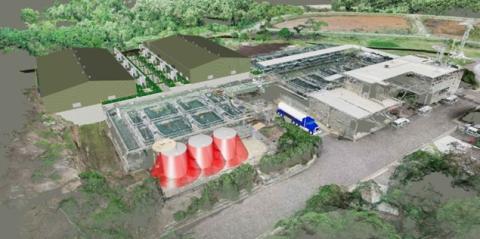Central Coast Council Water and Sewer is delivering a $82.5 million upgrade to Mardi Water Treatment Plan.
Central Coast Council’s Water and Sewer team are working with our contractors to deliver an $82.5 million upgrade to Mardi Water Treatment Plant.
The NSW Government provided $6.85 million through the Safe and Secure Water Program along with over $75 million from Central Coast Council.
The Mardi Water Treatment Plant typically provides around half of all drinking water to the Central Coast, future proofing this asset and ensuring it can continue to deliver safe and secure water to our customers is a key priority.
Once finished, Mardi Water Treatment Plant will be able to treat up to the equivalent of 64 Olympic-sized swimming pools, providing drinking water for over 210,000 homes and businesses across the Central Coast region and the lower Hunter.
Early works
Early works have already been completed to prepare the plant for this major upgrade including remediation of the sludge lagoons, upgrade of lagoon inlet structures and clearing of the south-western lagoon for the first time since it was constructed in 1982.
This will provide a reservoir to capture any untreated water during testing and commissioning of the new processes.
Desludging of the lagoon commenced in November 2019 and was completed in May 2023, removing over 30,000m3 of sludge from the lagoon.
Who is conducting the upgrades?
Delivery of the new state-of-the-art augmentation of Mardi Water Treatment Plant has been secured with the award of a Design and Construct Contract to Abergeldie Contractors Pty Ltd.
How are the upgrades being funded?
The NSW Government’s Safe and Secure Water Program has injected $6.85 million into the project along with over $75 million from Central Coast Council to deliver a world-class water treatment plant.
Why are these upgrades needed?
Mardi Water Treatment Plant currently treats water via direct filtration, meaning water from our catchments is fed directly to the filters following coagulation and flocculation. The latter processes create flocs, which are later removed in the filters. If the level of suspended solids in the raw water is high, the flocs can block the filters, reducing filter runtime and the plant’s overall capacity to produce water. In this way, the treatment process is affected by environmental factors such as storm events and algal blooms which can lead to the deterioration of raw water quality entering the plant, putting pressure on the filtration system.
As certain water quality risks and regional demands increase, and to optimise the efficiency of water storages for the future, Mardi Water Treatment Plant requires upgrades to ensure it can still produce up to 160 million litres of water per day into the future under all projected raw water quality conditions.


What are the key upgrades?
The key component of the upgrade is the addition of a Dissolved Air Flotation (DAF) clarifier along with new flocculation tanks. The DAF process uses a saturated air stream to generate bubbles which attach to flocs and bring them to the surface. The flocs are then skimmed off the surface using a mechanical scraper system.
The DAF clarification system will improve the plant’s performance in poor raw water conditions by removing suspended particles significantly reducing the turbidity of the raw water. The DAF is also the most robust system for algae removal, allowing Mardi Water Treatment Plant to continue treating water from Mardi Dam during algal blooms, rather than sourcing water from the region’s drought contingency storage.
Works will also include the conversion of the coagulant used to create flocs from Aluminium Sulphate to Ferric Chloride. This includes upgrades to the storage, delivery, and dosing system. Using Ferric Chloride will decrease the levels of Total Organic Carbon (TOC) in the water, improving flexibility to manage disinfection residuals in the network, reducing the risk of bacterial contamination and the need to re-chlorinate. A new Cationic Polymer dosing system will work in conjunction with the coagulant to maximise efficiency.
A new PAC storage and dosing facility will also be constructed, and the existing flocculation tanks will be repurposed as Powdered Activated Carbon (PAC) contact tanks. This will improve the plant’s ability to remove taste and odour compounds that can occur in the raw water.
Baffles and a trim chlorine dosing system are being added to the existing clearwater tank, which stores treated water before being distributed to the water supply network. The addition of baffles will increase chlorine contact time, allowing for more effective disinfection of water and increasing the safety of drinking water distributed to customers.
The upgrade will also involve a new access road, electrical switch rooms, sludge lagoon outlet structure and the refurbishment and upgrade of existing facilities at the treatment plant.
What is the current status?
The 50% design documentation is in progress with construction due to commence in early 2024.